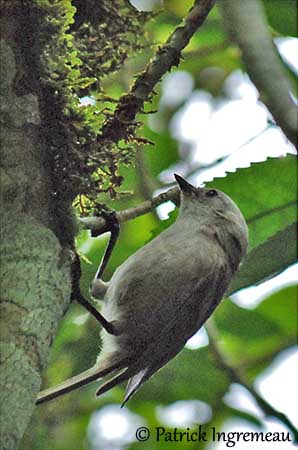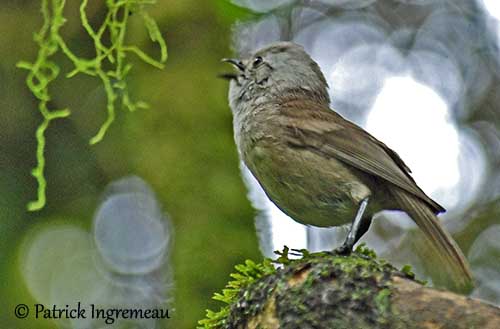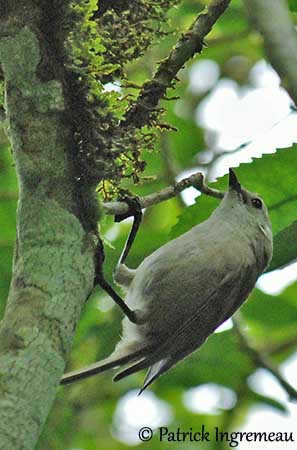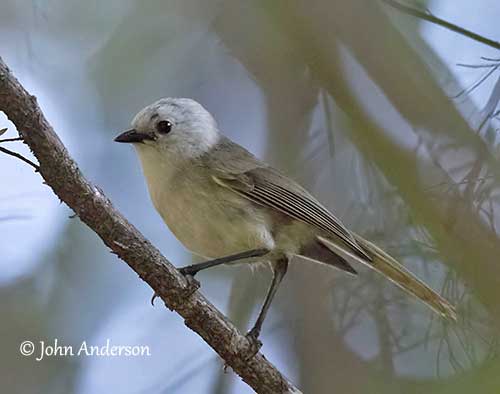
Fr: Mohoua à tête blanche
Ang: Whitehead
Maori: Popokatea, Popokotea
All: Weißköpfchen
Esp: Mohoua Cabeciblanco
Ita: Testabianca
Nd: Witkopmohoua
Sd: Vitmohoua
Photographers:
John Anderson
John Anderson Photo Galleries
Patrick Ingremeau
TAMANDUA
Text by Nicole Bouglouan
Sources:
HANDBOOK OF THE BIRDS OF THE WORLD Vol 12 by Josep del Hoyo-Andrew Elliott-David Christie - Lynx Edicions - ISBN: 8496553423
KNOW YOUR NEW ZEALAND BIRDS by Lynnette Moon - New Holland Publishers – ISBN: 1869660897
BirdLife International (BirdLife International)
New Zealand bird status between 2008 and 2012
New Zealand birds and birding (Narena Olliver)
Wikipedia, the free encyclopaedia
Te Ara – The Encyclopedia of New Zealand
Tiritiri Matangi Open Sanctuary
Page family Mohouidae
Page Passeriformes Order
Whitehead
Mohoua albicilla
Passeriformes Order – Mohouidae Family
INTRODUCTION:
The Whitehead is endemic to New Zealand and occurs on North Island. This species is closely related to the Yellowhead of South Island.
The Whitehead is a forest bird common in native forest. However, the habitat has been destroyed by deforestation, and this species is threatened by rats and stoats. Reintroduction of birds into reserves has allowed the recovery of some populations.
DESCRIPTION OF THE BIRD:
Biometrics:
Length: 15 cm
Weight: 15-18 gr
The adult has compact body, long legs and short tail.
Head and underparts are white or whitish, with sometimes pale brownish-grey wash on neck. Flanks are slightly tinged pale grey-brown.
The upperparts are brown-grey. The upperwing is brown with slightly darker coverts. The tail is brown.
Bill, legs and feet are black. The eyes are dark brown.
The female is similar but she has crown and hindneck washed brown.
The immature resembles adult female.

RANGE:
The Whitehead occurs on North Island, New Zealand, where it is locally common south of a line from Pirongia Forest, Hamilton and Te Aroha. The species has been reintroduced into reserves and offshore islands, but they are naturally common on Little Barrier and Kapiti Islands.
HABITAT:
The Whitehead can be common in large tracts of forest and frequents tall native forest, pine forest, scrub and dense shrubland.
CALLS AND SONGS: SOUNDS BY XENO-CANTO
The Whitehead is very social and usually lives in groups. Various chirps and chatters can be heard, constantly uttered as contact within the group. Repeated “zwit” or “chip” are used as contact calls.
The male gives loud territorial calls including rapid musical chirps, often followed by canary-like trills. It usually sings from prominent perches.

BEHAVIOUR IN THE WILD:
The Whitehead feeds mainly on invertebrates such as caterpillars, spiders, beetles and moths, but it may also eat some small fruits and seeds from native plant species.
It feeds rarely on the ground, but it is very active while foraging in trees. It uses its bill to remove pieces of bark or break up wood, to reach the hidden invertebrates. It also hangs from small branches while gleaning invertebrates from leaves. It usually climbs about foliage or clings to the bark while using the short tail as additional support.

The Whiteheads are monogamous, and the pairs may have several helpers, up to six, usually young of the previous year. They are territorial during the breeding season. The displays are fairly similar to those of the Yellowhead. Two males approach a female with spread wings and tail. They move to each side of the female. They lower their quivering wings while the tail is fanned. The males bow with raised tail, twisting and turning their body. They move close to the female while changing from one side to the other one. These displays end when the female selects one male.
The Whitehead is sedentary in its range. It may perform local movements, and some juveniles disperse whereas others remain in the territory.
This species is a reluctant flier, but it is very agile when foraging in trees.
REPRODUCTION OF THIS SPECIES:
The breeding season occurs from October to January.
The female builds the nest, a neat, tightly woven cup made with grass, leaves, rootlets, twigs and moss. These materials are held together with spider web. The cup is lined with moss, vegetal fibres or tree-fern scales.
The nest is placed in tree fork or in shrubs, and hidden among the dense canopy foliage.

The female lays 3-4 white or pinkish eggs with fine darker markings. She incubates alone during 17-19 days during which she is fed by her mate and helpers. The chicks are also fed by all the member of the group. They fledge 16-19 days after hatching, and still depend on parents and helpers for food during some weeks, and sometimes for several months. Some of the juveniles often remain as helpers for up to 30 months. The female often starts a new brood while male and helpers tend the juveniles.
The Whitehead’s nest is often parasitized by the Long-tailed Cuckoo. When the cuckoo chick hatches, it ejects eggs and /or chicks of the host and is raised alone.
PROTECTION / THREATS / STATUS:
The Whitehead’s populations declined in the past due to deforestation and introduced predators. They are vulnerable to fragmentation of the habitat because they rarely fly or cross open areas.
After the extinction of the North Island population in the late 1800s, only two natural populations, one on Little Barrier Island and the other on Kapiti Island survived. These birds heave been successfully used for translocation into several islands.
Numbers are unknown, but the species is fairly common in protected areas, and currently listed as Least Concern.
